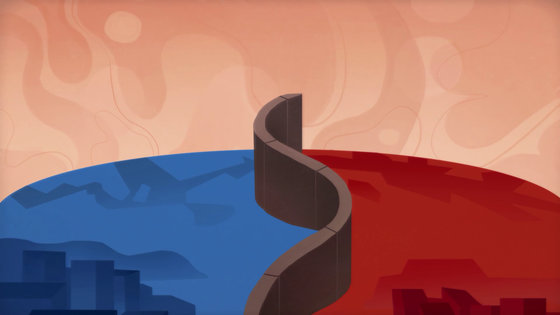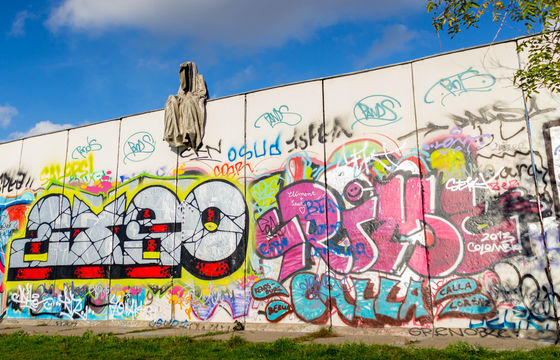Experts pointed out that `` East and West Germany is divided '' even after 30 years have passed since the fall of the Berlin Wall

by
Prof. Nathan Stoltzfas, who continues to study the massacre and Holocaust that Nazi Germany performed against Jews at Florida State University, insisted on the overseas media The Conversation that 'East and West Germany are still fragmented' It is.
30 years after the Berlin Wall came down, East and West Germany are still divided
https://theconversation.com/30-years-after-the-berlin-wall-came-down-east-and-west-germany-are-still-divided-126589
On November 9, 1989, the Berlin Wall that divided Germany from east to west collapsed . Berlin Wall Cold War and the West camp to effect a capitalist-liberal Europe in the days, were divided on the east side camp that aspire to communism, socialism, Iron Curtain is a structure that symbolizes.
The Berlin Wall was completed in 1961 and continued to physically separate East and West Germany for 28 years until 1989. The west side of the Berlin Wall is capitalist state West Germany and the east side is Communist state East Germany, and during the Cold War, an estimated millions of people tried to cross the Berlin wall to exile from the east to the west It has been.
However, in September 1989, shortly after the fall of the Berlin Wall, demonstration activities for democratization became active in East Germany. This leads to the final collapse of the Berlin Wall. The following article summarizes in detail why the Berlin Wall was constructed and why it was destroyed.
A movie that shows why the symbol of the East-West Cold War `` Berlin Wall '' was built and why it was destroyed-GIGAZINE

The day after the fall of the Berlin Wall , Billy Brandt , who had previously been prime minister of West Germany, commented, “We Germans will challenge more to bring the nation together.” However, according to Professor Storzfass, “30 years have passed since the fall of the Berlin Wall, but the east-west gap seems to be widening.”
Many scholars, such as Professor Stolzfas, claim that there is still a gap between east and west, and the novelist Peter Schneider says that the `` head ' ' is different from a physical wall like the Berlin Wall . Pointed out the existence of a “ wall inside ”. A column at The New York Times about the “partition” experienced by the child generation of people raised in parted Germany
Tearing Down Berlin's Mental Wall-The New York Times
https://www.nytimes.com/2011/08/13/opinion/tearing-down-berlins-mental-wall.html

Helmut Cole , a politician from West Germany who has achieved the reunification of East and West Germany, will lead the plan to grow together Germany, which was divided by the power of capitalism after the reunification of Germany. Under this plan, it was promised to supply “Employment”, “High standard of living” and “Consumer products” to the east side, which were not in East Germany. According to the plan, basically, after the unification of East and West Germany, the West German system was expanded to the east.
However, as Cole was concerned, German entrepreneurs were reluctant to establish a production base in the eastern part of East Germany, and it seems that there was a situation where the production base was increased only in the western part . In addition, many factories that had been operating in the east were once closed and the base was moved to the west. In other words, Professor Stratzfas argues that the German economy remained largely separated from the east and west after the reunification.
Still, the Western people who advocate capitalism and democracy seemed to have insisted that capitalism and democracy would soon make East Germans West Germans.

by
In the 1990s, even younger generations from East Germany who were almost unrelated to socialism were not “Federal Republic” citizens after their reunification, but “East German” citizens who had already disappeared The survey reveals that many people feel that. The reason why the young generation still had a strong nostalgia for East Germany was because their parents were communists and heard many episodes of the East German period at the table.
It is unclear whether the communist parents told their children what was exaggerated, but the oral tradition was supported by the perception that 'the east side is now dominated by the west' Professor Stolzfas said that it was. In other words, Professor Storzfas points out that communists who support the east did not really want the west or capitalism.
It is also clear that it is not just the eastern people who are not willing to reunite Germany. According to a poll conducted by Der Spiegel, the news magazine with the highest number of publications in Europe, 63% of West Germans agreed to accept East Germans to the west before the fall of the Berlin Wall, but the wall collapsed Two months later, a similar survey was conducted, and the percentage of supporters had dropped to 33%.
One of the reasons why the western people have responded cold to the east is the “tax increase”. Germany decided to focus on the eastern economic development as a nation by east-west unification, but those from West Germany were worried that funds would be collected from the people by 'tax increase' .

by Christian Dubovan
Furthermore, people who have been exiled from East Germany to West Germany when Germany was divided in the east and west have been persecuted, such as being bullied by a child who was raped at school, such as `` East German pig '' It seems that the psychological gap between East and West Germany remained after the reunification, as in some cases it developed to appeal to the school principal .
In the 1990s, persecution of foreign refugees occurred in Brandenburg in eastern Germany. In Brandenburg, there were three times more violent incidents in western Germany, so the argument that socialism was not able to nurture people from East Germany to accept West Germany's pluralist ideas It happened in Germany, and here again, the psychological gap between East and West Germany was emphasized.
On the other hand, in 1992, in Munich, the former territory of West Germany, the movement to dispel the German image of “tolerance to demonstration activities” accelerated, resulting in millions of people including German politicians and the Jewish Community Union Gathered, and demonstration activities were conducted to deny Nazism and protect democracy. Again, the divide between liberal westers and exclusive easterns is highlighted.

by
And in Germany today, the idea of neo- Naziism to restore Nazism is expanding. The German right-right party formed in 2013, `` Options for Germany (AfD) '' is also spreading year by year, and finally succeeded in entering the national government in the 2017 German Federal Election in September 2017 .
In particular, more than one million refugees in the Middle East and Asia faced a death crisis, and German Prime Minister Angela Herkel commented that AfD's support increased in the eastern region of Germany shaken by the refugee problem . It was.
After AfD became the first far-right party to advance into national politics in 2017, it also received the second highest number of seats in the eastern Thuringian state legislature, gaining more support than the major parties.
The German conservative ruling party is the German Christian Democratic Alliance and the Christian Social Alliance . According to a poll conducted in early 2019 , the German Christian Democratic Alliance has a high approval rating of 77% in western Germany. However, 42% in the east. That is why the German Christian Democratic Union is also considering forming a coalition with AfD, professor Stratzfas wrote.

by Christian Wiediger
Prof. Storzfas points out that the rise of AfD embodies the global anger of democracy, and those from eastern Germany feel alienated and helpless, and about half of them are second-class citizens It is clear from the survey that it is obscene. In the case of those who are from the West, the percentage of those who are obsessed with being a second-class citizen seems to have decreased to 37%, and it is clear that those from the East are feeling mentally pressured.
Since the reunification of Germany, Germany has narrowed the economic disparity within the country through various measures. However, there are still data that disparities exist. For example, the average unemployment rate in 2018 was 6.9% in the east, but only 4.8% in the west. A survey of German salary data in 2017 reveals that only 86% of western Germans are paid for eastern Germans.
In addition, the trend of “putting the production base in the west” that occurred when Germany was just reunified has been reflected to date. There is no major company headquartered in eastern Germany, and no company is listed on the Frankfurt Stock Exchange, one of Germany's major stock exchanges.
Professor Storzfas interviewed Egon Krenz in 1991, the last leader of the former East Germany. At that time, Krenz said, “The Berlin Wall should have been left intact,” said the former East German government should have paid more attention to the East Germans.
Lastly, Professor Stolzfas said, “The 30th anniversary of the fall of the Berlin Wall is how difficult it is for humans to pay daily sacrifices for people outside their group, and the German government has changed eastern Germany as western. It ’s a good opportunity to ponder what you ’ve actually done to make it happen. ”
Related Posts:
in Note, Posted by logu_ii







